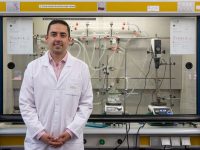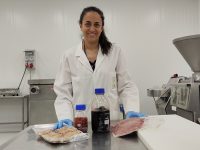|
Our planet is a tiny blue dot lost in the vast space of the universe. And we humans have been its inhabitants for just a brief instant of time. All of Earth’s living systems organised and evolved from the atoms of the galaxy trapped within it. The atoms of our body, of animals, of fungi, of plants and of microorganisms come from our planet and were part of the great stellar disc that gave rise to the solar system. Therefore, we are «flesh and blood», but we also are «stardust». And each individual that lives today on Earth is the product of the continuous and uninterrupted replication of the nucleic acids that began to multiply during the origin of life, less than 4,000 million years ago. The planet Earth, like most of the components of the solar system, was formed about 4,550 million years ago. Cellular life appeared on Earth when the planet was still very young, about 3,850 million years ago. The continuity and unity of life that we know today are evident in the uniformity of the genetic systems and molecular composition of living cells. During the first 2,000 million years of evolution, prokaryotic microorganisms (bacteria and archaea) were Earth’s only inhabitants, and they «invented» almost all the metabolic strategies known today. For millions of years prokaryotes evolved on Earth, but in the process several «mistakes» happened. A metabolic «mistake», the production of oxygen, provided the foundation for aerobic life, and a strategic «mistake», endosymbiosis, produced the eukaryotic cell. Evolution connects life through time such that, as in any evolutionary process, subsequent organisms and systems would not have arisen without the organisms and systems that preceded them. Thus, plants, fungi and animals emerged from a microbial world and they have maintained their close bond of dependence on microorganisms. The origin of life (or biopoiesis) may have taken place in our planet—perhaps even several times—shortly after the stabilization of liquid water, something that took place around 3,900 millon years ago. If biopoiesis occurred on Venus or Mars during some point in the «geologic» history of these planets, it ultimately failed. What made the preservation of life on Earth possible was the development food chains, of ecosystems (or ecopoiesis), which prevented depletion of the biogenic elements of the planet’s surface. This would have happened over a maximum period of 200 or 300 million years after the first microorganisms, and would have caused the early extinction of life. However, the establishment of food chains, in which the metabolic products of some organisms serve as nutrients for others, allowed the recycling of matter and has sustained life. The appearance of ecosystems was therefore essential because, while solar energy is seemingly limitless, that is not the case with the matter available on Earth. The ability of microorganisms to make maximum use of both energy and recycled matter has ensured the continuity and permanence of life on Earth. Indeed, the activity of the first ecosystems determined the subsequent evolution of the planet, which until approximately 1,800 million years ago was inhabited solely by prokaryotes. Prokaryotes are essential members of the biosphere because they are indispensable components of the ecosystems that enable the functioning of all biogeochemical cycles. The two fundamental enzymes of the biosphere, rubisco (which fixes CO2 to a pentose in the photosynthesis process), and nitrogenase (which converts atmospheric N2 into organic nitrogen), are exclusively produced by prokaryotes. Most of the photosynthetic bacteria and chloroplasts (which are descendants of cyanobacteria) contain rubisco. Many free bacteria and some symbionts (Rhizobium, etc.) of legumes and a few other plants contain nitrogenase. Microorganisms are the main, if not the only organisms that are responsible for the degradation of a great variety of organic compounds, such as cellulose, hemicellulose, lignin and chitin (the most abundant organic compounds on Earth). If it was not for this microbial degradation, organic matter would accumulate in forests and sediments. In addition, microorganisms are able to degrade many of the toxic chemical compounds derived from anthropogenic activity, including polychlorinated biphenyls, dioxins and pesticides. Moreover, microorganisms have a fundamental role in the recycling of atmospheric gases and are, for example, responsible for the «greenhouse» effect. Therefore, on the one hand, microorganisms sustain life on our planet but, paradoxically, on the other, they are the cause of the global increase in temperature, thus placing the continuance of life (at least the life of eukaryotes) in danger. Prokaryotic microorganisms are everywhere. Their ubiquity is based on five main characteristics that were lost during subsequent stages of evolution: (i) their small size, which gives them a great capacity for dispersion; (ii) their variability, which allows them to occupy highly diverse ecological niches; (iii) their metabolic flexibility, which allows them to tolerate unfavourable environmental conditions and to quickly adapt to other conditions; (iv) their genetic plasticity (including their capacity for the horizontal transfer of genes), which allows them to recombine and accumulate favourable characters and (v) their ability to enter anabiosis (during which they are alive but metabolically inactive), which allows them to persist for a long time (even millions of years in some cases), waiting for a return of advantageous environmental conditions. All living beings depend on prokaryotic life. Prokaryotes are present in all places where life is possible, in environments ranging from the «ideal» (obviously, from the point of view of macroorganisms) to the extreme (unthinkable for animals, fungi and plants). If we knew nothing about microorganisms we would have a limited and inaccurate understanding of biology: we would not know that there can be life under extreme temperature, salinity or pH conditions; we would know only about aerobic and oxygenic photosynthesis and remain ignorant about its anaerobic and anoxygenic origin in prokaryotes and we would believe that the longest-living forms of life on Earth are, for instance, 1,000 year-old redwoods, which are but «infants» compared to the endospores of Bacillus. The Earth is a great rock in space, but it is a living rock that has undergone multiple changes in form and will continue to do so. About 5,000 million years from now, our Sun, like its predecessor star, will turn into a red giant star, expanding and burning all the planets surrounding it. Not even bacteria, which have inhabited our planet since the origin of life and have survived more than 30 massive extinctions, will escape this catastrophe. Or will they? Some scientists think that endospores or other forms of bacterial resistance have escaped from Earth in the small fragments of rocks detached by the violent impacts of asteroids. Since then, these microbial stowaways have roamed by the space, looking for new planets to inhabit and «conquer». |

Illustration: Carles Puche «All of Earth’s living systems organised and evolved from the atoms of the galaxy trapped within it» «About 5,000 million years from now, our Sun, like its predecessor star, will turn into a red giant star, expanding and burning all the planets surrounding it» |
Search
© Mètode 2015 - 85. Online only. Living with climate change - Spring 2015
Ricard Guerrero
Member of the Institute of Catalan Studies and Academic Director of the Barcelona Knowledge Hub of the Academia Europaea.
Mercè Berlanga
Tenure-track 2 professor of the Department of Microbiology and Parasitology of the University of Barcelona (Spain).





